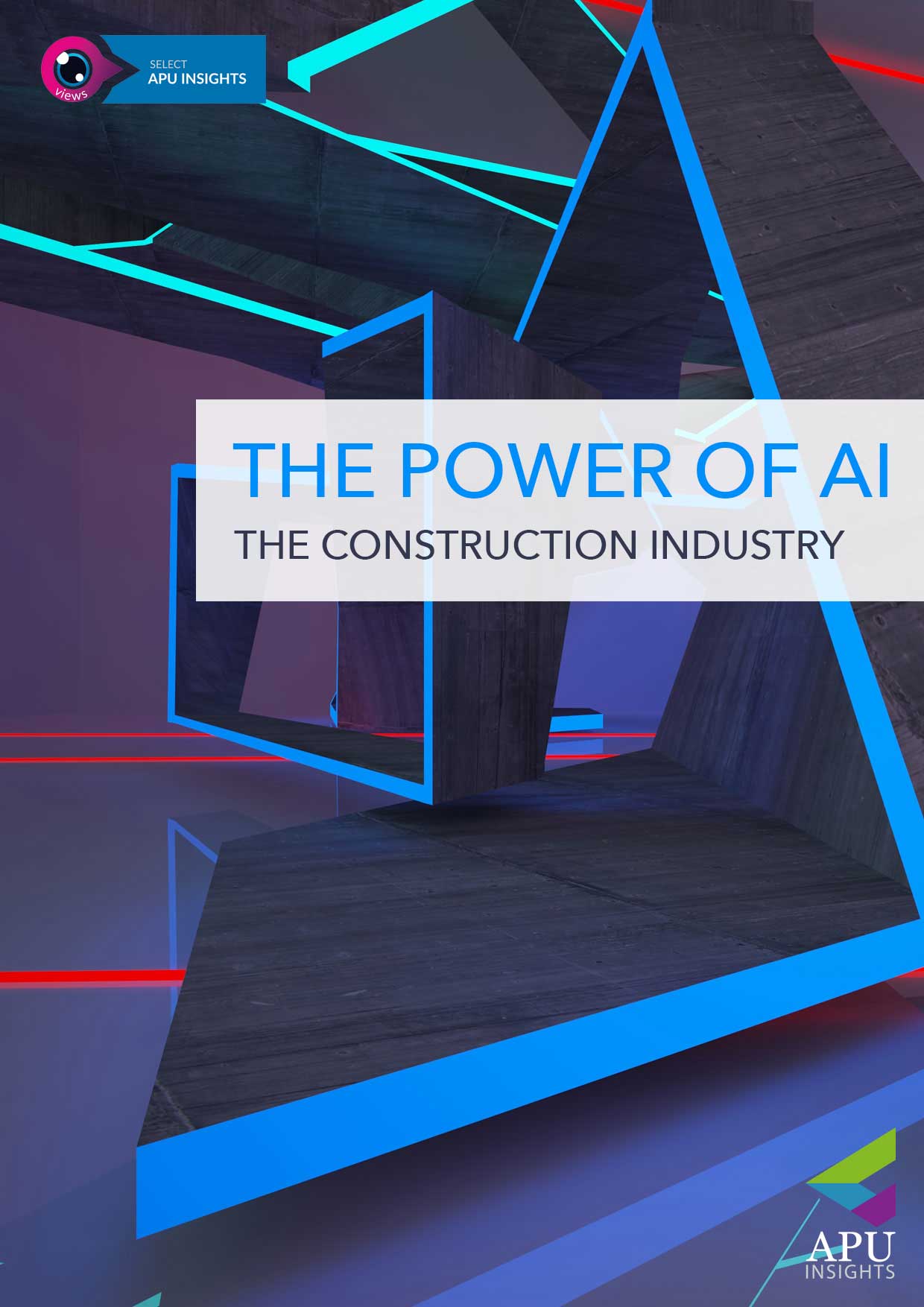The Power of AI: The construction industry
Dr. Evangelo Damigos; PhD | Head of Digital Futures Research Desk
- AI
- Sustainable Growth and Tech Trends
Publication | Update: Sep 2020

According to Sameer Dhanrajani,of all the game-changing innovations driven by technology and artificial intelligence, the potential of the construction industry remains untapped.
According to McKinsey, the engineering and construction sector globally is valued to be worth $ 10 tn per year. While that is a respectable size, the construction industry overall has largely been slow in the uptake of inventions in the technology arena. In fact, several construction business houses in India tend to be family-owned and extremely traditionally-run, and have tremendous inertia in embracing new age technologies.
However, the past few years is seeing a change in the way construction firms operate. While McKinsey expects the permeation of AI in the construction industry to be modest right now, it does represent an opportunity for early adopters to catch the bull by the horns and build a sizeable competitive advantage.
According to the Market Research Future “Global AI in Construction Market Research Report” AI-enabled applications in the construction sector have been at a burgeoning stage and are presumed to witness their integration with building information modelling (BIM) and GPS which would be very beneficial for project planning, scheduling, and inventory purposes. Moreover, the AI is anticipated to support the construction sector in mitigating the existing and repetitive challenges of accuracy margin, project schedule delay, and safety concerns which are presumed to be one of the major propelling factors for the growth of AI in construction market over the assessment period. On the flip side, slow adoption rate of AI in the construction sector and complex algorithms for developing construction specific programs are expected to inhibit the growth of AI in construction market over the forecast period.

The AI in construction market is differentiated by stage, component, technology, deployment, organization size, and application.
On the basis of stage, the market is categorized into pre-construction, construction stage, and post-construction. By component, the AI in construction market is sub-segmented as solutions and services. The solution segment is categorized as virtual assistant, design & planning, revenue estimation, demand forecasting, predictive maintenance, and others. The service sub-segment comprised training & consulting, implementation services, and other support services.
On the basis of technology, the market is segregated into neural networks, machine learning & deep learning, and natural learning programming (NLP). Additionally, on the basis of deployment, the market is bifurcated into on-cloud and on-premise. Depending on the organization size, the market is classified as large enterprises, and small & medium enterprise. On the basis of application, the market is categorized as, building information management, schedule management, project management, risk management, equipment management, and supply chain management.
There are various avenues to explore the AI potential for the engineering & construction industry:

Image recognition for managing risk, safety and quality
AI-powered image recognition and algorithm accuracy in image detection has improved substantially due to advances in deep learning and neural networks. Numerous use cases of image recognition and video analytics are now being seen in areas as diverse as retail, consumer goods, insurance, healthcare, etc.
The construction industry would do well to adopt these techniques and apply them to manage risk and worker safety. Working conditions in the construction industry for labourers tend to be managed on an adhoc basis at present. Other cases also include unsafe working environments where certain infrastructure in overall construction projects are unsafe for human work.
Construction companies could employ drones to capture images and videos of their construction sites on a continuous basis. By applying deep learning and other AI techniques, firms would be able to identify unsafe workplace behaviour as well as unsafe working environments and run training interventions to improve the safety quotient of their workplaces.
Continuous design optimisation
With data readily available for analysis, AI can help continuously optimize the design of each project. A recommender system-like approach would help contractors and engineers identify the right design as well as the materials required to execute it. Additionally, AI-powered technology could also help recommend architectural finishes based on the proposed design – thus enabling construction firms to finalize the design and material requirements early in the schedule, and finish construction faster.
Increasing talent retention and development
The construction sector is remarkably disorganized and heavily relies on contract labour for executing a project. While minor, the cost and time involved in fulfilling positions left by ex-labourers and training new entrants really adds up and reduces the overall efficiency in project management.
AI has been applied to talent retention and talent development use cases in multiple industries, and the same can be applied to the construction industry with relative ease. With unsupervised machine learning algorithms, contractors and their parent companies will be able to forecast talent shortage accurately, and plan to backfill labour resources efficiently. AI can also enable improved labour retention strategies by recommending best options for ensuring improved talent retention and availability.
Project schedule optimisation
Construction projects are typically long drawn with a sizeable period elapsing between envisioning the project to having it commercially ready. In this period, we often see many niggles with respect to the project schedule. Overuse of materials, time-consuming nature of restocking, people availability issues – all these can throw the overall project plan into disarray.
An AI-backed schedule optimisation and forecasting solution can reduce the time and cost overruns associated with these delays. Using the data from benchmarked previous projects, managers would be able to run sophisticated analyses using AI to forecast the timelines of the next activity in the construction cycle.
Preventive maintenance through AI
Maintenance in the construction industry happens largely at two levels. Firstly, it is the maintenance of a partially and incrementally developing property. The second is when the builder organisation is responsible for the continuing maintenance after it has been leased out to tenants. At both levels, maintenance can be a hugely cumbersome and time-consuming activity, albeit critical, that the construction company must perform in order for operations to move smoothly.
Conclusion
AI can complement human effort in the process of preventive maintenance. By using sensors and cameras as the data capture layer, and applying machine learning algorithms over the data, facility managers can monitor their property with greater ease and identify guided interventions on where maintenance activity is required. Using this data can be doubly productive as it will provide the system inputs on when routine maintenance activity for all the working components of a modern property are required, and schedule accordingly.
 Digital Themes: AI, Sustainable Growth and Tech Trends
Digital Themes: AI, Sustainable Growth and Tech Trends

HTML
 Access Rights | Content Availability:
Access Rights | Content Availability: 


Objectives and Study Scope
This study has assimilated knowledge and insight from business and subject-matter experts, and from a broad spectrum of market initiatives. Building on this research, the objectives of this market research report is to provide actionable intelligence on opportunities alongside the market size of various segments, as well as fact-based information on key factors influencing the market- growth drivers, industry-specific challenges and other critical issues in terms of detailed analysis and impact.
The report in its entirety provides a comprehensive overview of the current global condition, as well as notable opportunities and challenges.
The analysis reflects market size, latest trends, growth drivers, threats, opportunities, as well as key market segments. The study addresses market dynamics in several geographic segments along with market analysis for the current market environment and future scenario over the forecast period.
The report also segments the market into various categories based on the product, end user, application, type, and region.
The report also studies various growth drivers and restraints impacting the market, plus a comprehensive market and vendor landscape in addition to a SWOT analysis of the key players.
This analysis also examines the competitive landscape within each market. Market factors are assessed by examining barriers to entry and market opportunities. Strategies adopted by key players including recent developments, new product launches, merger and acquisitions, and other insightful updates are provided.
Research Process & Methodology

We leverage extensive primary research, our contact database, knowledge of companies and industry relationships, patent and academic journal searches, and Institutes and University associate links to frame a strong visibility in the markets and technologies we cover.
We draw on available data sources and methods to profile developments. We use computerised data mining methods and analytical techniques, including cluster and regression modelling, to identify patterns from publicly available online information on enterprise web sites.
Historical, qualitative and quantitative information is obtained principally from confidential and proprietary sources, professional network, annual reports, investor relationship presentations, and expert interviews, about key factors, such as recent trends in industry performance and identify factors underlying those trends - drivers, restraints, opportunities, and challenges influencing the growth of the market, for both, the supply and demand sides.
In addition to our own desk research, various secondary sources, such as Hoovers, Dun & Bradstreet, Bloomberg BusinessWeek, Statista, are referred to identify key players in the industry, supply chain and market size, percentage shares, splits, and breakdowns into segments and subsegments with respect to individual growth trends, prospects, and contribution to the total market.
Research Portfolio Sources:
Global Business Reviews, Research Papers, Commentary & Strategy Reports
M&A and Risk Management | Regulation

The future outlook “forecast” is based on a set of statistical methods such as regression analysis, industry specific drivers as well as analyst evaluations, as well as analysis of the trends that influence economic outcomes and business decision making.
The Global Economic Model is covering the political environment, the macroeconomic environment, market opportunities, policy towards free enterprise and competition, policy towards foreign investment, foreign trade and exchange controls, taxes,
financing, the labour market and infrastructure.
We aim update our market forecast to include the latest market developments and trends.
Review of independent forecasts for the main macroeconomic variables by the following organizations provide a holistic overview of the range of alternative opinions:
As a result, the reported forecasts derive from different forecasters and may not represent the view of any one forecaster over the whole of the forecast period. These projections provide an indication of what is, in our view most likely to happen, not what it will definitely happen.
Short- and medium-term forecasts are based on a “demand-side” forecasting framework, under the assumption that supply adjusts to meet demand either directly through changes in output or through the depletion of inventories.
Long-term projections rely on a supply-side framework, in which output is determined by the availability of labour and capital equipment and the growth in productivity.
Long-term growth prospects, are impacted by factors including the workforce capabilities, the openness of the economy to trade, the legal framework, fiscal policy, the degree of government regulation.
Direct contribution to GDP
The method for calculating the direct contribution of an industry to GDP, is to measure its ‘gross value added’ (GVA); that is, to calculate the difference between the industry’s total pretax revenue and its total boughtin costs (costs excluding wages and salaries).
Forecasts of GDP growth: GDP = CN+IN+GS+NEX
GDP growth estimates take into account:

Market Quantification
All relevant markets are quantified utilizing revenue figures for the forecast period. The Compound Annual Growth Rate (CAGR) within each segment is used to measure growth and to extrapolate data when figures are not publicly available.
Revenues
Our market segments reflect major categories and subcategories of the global market, followed by an analysis of statistical data covering national spending and international trade relations and patterns. Market values reflect revenues paid by the final customer / end user to vendors and service providers either directly or through distribution channels, excluding VAT. Local currencies are converted to USD using the yearly average exchange rates of local currencies to the USD for the respective year as provided by the IMF World Economic Outlook Database.
Industry Life Cycle Market Phase
Market phase is determined using factors in the Industry Life Cycle model. The adapted market phase definitions are as follows:

The Global Economic Model
The Global Economic Model brings together macroeconomic and sectoral forecasts for quantifying the key relationships.
The model is a hybrid statistical model that uses macroeconomic variables and inter-industry linkages to forecast sectoral output. The model is used to forecast not just output, but prices, wages, employment and investment. The principal variables driving the industry model are the components of final demand, which directly or indirectly determine the demand facing each industry. However, other macroeconomic assumptions — in particular exchange rates, as well as world commodity prices — also enter into the equation, as well as other industry specific factors that have been or are expected to impact.
Forecasts of GDP growth per capita based on these factors can then be combined with demographic projections to give forecasts for overall GDP growth.
Wherever possible, publicly available data from official sources are used for the latest available year. Qualitative indicators are normalised (on the basis of: Normalised x = (x - Min(x)) / (Max(x) - Min(x)) where Min(x) and Max(x) are, the lowest and highest values for any given indicator respectively) and then aggregated across categories to enable an overall comparison. The normalised value is then transformed into a positive number on a scale of 0 to 100. The weighting assigned to each indicator can be changed to reflect different assumptions about their relative importance.

The principal explanatory variable in each industry’s output equation is the Total Demand variable, encompassing exogenous macroeconomic assumptions, consumer spending and investment, and intermediate demand for goods and services by sectors of the economy for use as inputs in the production of their own goods and services.
Elasticities
Elasticity measures the response of one economic variable to a change in another economic variable, whether the good or service is demanded as an input into a final product or whether it is the final product, and provides insight into the proportional impact of different economic actions and policy decisions.
Demand elasticities measure the change in the quantity demanded of a particular good or service as a result of changes to other economic variables, such as its own price, the price of competing or complementary goods and services, income levels, taxes.
Demand elasticities can be influenced by several factors. Each of these factors, along with the specific characteristics of the product, will interact to determine its overall responsiveness of demand to changes in prices and incomes.
The individual characteristics of a good or service will have an impact, but there are also a number of general factors that will typically affect the sensitivity of demand, such as the availability of substitutes, whereby the elasticity is typically higher the greater the number of available substitutes, as consumers can easily switch between different products.
The degree of necessity. Luxury products and habit forming ones, typically have a higher elasticity.
Proportion of the budget consumed by the item. Products that consume a large portion of the
consumer’s budget tend to have greater elasticity.
Elasticities tend to be greater over the long run because consumers have more time to adjust their behaviour.
Finally, if the product or service is an input into a final product then the price elasticity will depend on the price elasticity of the final product, its cost share in the production costs, and the availability of substitutes for that good or service.
Prices
Prices are also forecast using an input-output framework. Input costs have two components; labour costs are driven by wages, while intermediate costs are computed as an input-output weighted aggregate of input sectors’ prices. Employment is a function of output and real sectoral wages, that are forecast as a function of whole economy growth in wages. Investment is forecast as a function of output and aggregate level business investment.




 Industry: Cross-Industry
Industry: Cross-Industry 
